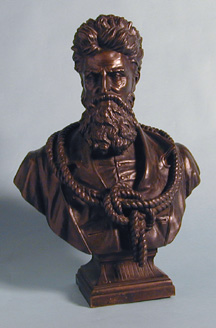John Brown (1800-1859)
Introduction
This exhibit attempts to highlight Oberlin's relationship with John Brown. John Brown was born in Torrington, Connecticut on May 9, 1800, the son of Owen and Ruth Brown. The Brown family moved to Hudson, Ohio when John was five years old. Owen Brown served as a member of the Oberlin Collegiate Institute's Board of Trustees from 1835 to 1844. During 1840 and 1841 John Brown failed in an attempt to negotiate with the Oberlin Collegiate Institute to settle his family on land known as the Gerrit Smith-Oberlin Virginia lands. In 1856, Oberlin College students Samuel S. Burdett and Henry P. Kinney joined abolitionist Brown in the conflict over slavery in Kansas. The specter of the sectionalism loomed large at the time. On October 16, 1859, Oberlinians John A. Copeland, Lewis Sheridan Leary, and Shields Green (a runaway slave) participated in Brown's raid on the Harpers Ferry arsenal. Leary died of a wound received in the raid, and Copeland and Green were hanged on December 16, 1859. A monument erected in 1860 to honor the three Oberlin men who lost their lives at Harpers Ferry can be found in the Martin Luther King, Jr. Park on Vine Street in Oberlin.
"This bust of the abolitionist John Brown was carved by the French sculptor Joseph-Charles de Blezer in 1870. College Trustee John Stern
'39 purchased the bust in Paris in 1976 and loaned it to the College. It remained in storage until historian Geoffrey Blodgett '53 received it as
a gift from Mr. Stern and displayed it in his Rice Hall office for 20 years. In 1999 College Archivist Roland Baumann accepted the bust (for the Archives)
for public viewing to celebrate Oberlin's strong anti-slavery holdings and heritage."
Geoffrey Blodgett to Roland Baumann,
December 23, 1999
Exhibit Contents
- Introduction & Bust of John Brown (1870)
- Ambrotype of Samuel Swifin Burdett, Gardner C. Trowbridge, and Henry Payson Kinney, who were involved in Bleeding Kansas (1856)
- Letter home by John A. Copeland (1859)
- Photograph of Lewis S. Leary, Harpers Ferry participant (c.1850s)
- "A Journey to Virginia in December, 1859," A Thursday Lecture by James Monroe (1898), p. 158-59.
Related Links
- Harpers Ferry Monument, courtesy of EOG
- "His Soul Goes Marching On: The Life and Legacy of John Brown," online exhibit by the West Virginia Archives and History in commemoration of the 150th anniversary of John Brown's raid on Harper's Ferry
- Additional letters of John Copeland, courtesy of EOG
